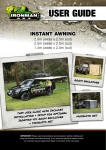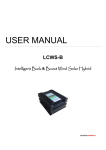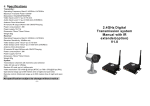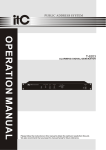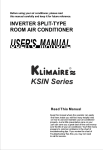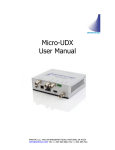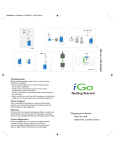Download Operating Instructions For ABO Butterfly Valves, Series 900
Transcript
Operating Instructions For ABO Butterfly Valves, Series 900 1. 2. 3. 4. 5. 6. 7. 8. 9. Introduction Safety Instructions Valve Identification Transportation and Storage Installation into Piping Pipe Pressure Test Operation and Maintenance Assistance in Case of Failure Valves with Electric or Pneumatic Actuator 1. Introduction Centric rubber seated valves ABO, Series 900 have been designed to close or regulate the flow of fluids in pipelines. The correct type and material design is determined using brochures or manufacturer's recommendations during consultations. 2. Safety Instructions Installation, operation and maintenance may only be performed by properly trained and instructed staff. For detailed safety regulations see the separate document, which must be read carefully before installation. 3. Valve Identification Series 600 is designed for normal use for water, hot water, air etc. The material of the disc is optional: cast iron, brass, stainless steel. The material of the seat (EPDM or NBR) is indicated on the label. Series 900 is designed for chemical, gas industry etc. applications. These valves have a label specifying the material, maximum temperature and pressure. 4. Transportation and Storage Valves must be stored indoors in dry and dust-free environment at normal temperatures. Valves must be stored in a slightly open position (never fully closed!). Valves must not be stacked on each other; this could cause damage to the collar. When transporting large valves using a crane, they should only be handled by attaching the rope to the body, not the actuator or the lever. 5. Installation into Piping The procedure is graphically described in the document Installation Instructions. Valve sealing surfaces are made of rubber gasket parts; it is therefore necessary to use flanges with flat sealing strips, e.g. B shape according to EN 1092. Before installation it is necessary to examine Whether the PN, DN and materials of the supplied valve corresponds to the intended use. Whether no damage occurred during transportation. Do not use damaged valves! Check the correct functioning of the valve (full opening and closing). Counter-flanges must be aligned and parallel; any impurities and solid particles from the flanges and piping must be removed. The direction of the flow and valve position are optiona. Horizontal position of the valve stem is recommended for DN ≥ 350. Flanges should be tightened so that a contact "metal to metal" between the flange and valve body is ensured. This is the only way to guarantee tightness (no other sealing is used). 6. Pipe Pressure Test The actual valve is pressurized by the manufacturer. When fitted in the pipeline the entire pipe section with valves needs to be pressurized. The following must be observed: Newly installed section must be carefully rinsed (cleaned) to remove all mechanical impurities. Valves in open position: pressure at 1.5 times the PN. Valves in closed position: pressure at 1.1 times the PN. 7. Operation and Maintenance Valves can be manually controlled using normal force, it is not recommended to extend the length of the lever. When the lever is parallel to the pipe the valve is opened; the position of the lever perpendicular to the pipe means that the valve is closed. Opening and closing using the lever must be gradual rather than abrupt, to avoid hydraulic shock. The valves are maintenance-free, it is only necessary to check during operation if the outer surface does not leak. If the valve remains in the same position for a long time, it is recommended to close and open the valve repeatedly at least 4 times per year. 8. Assistance in Case of Failure In case of failure and repair it is necessary to adhere to all safety rules - see the separate document Safety Instructions. 9. Valves with electric or pneumatic actuator The above principles fully apply to these valves. It is also necessary to observe and check the correct end position adjustment of the actuators. The positions of the actuators have been pre-set by the manufacturer and may not be adjusted. The intake (or exhaust) of controlling air in pneumatic actuators can be adjusted to avoid their quick closure and hydraulic shock in the pipes.



